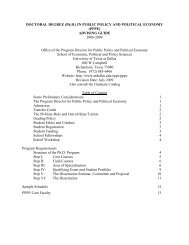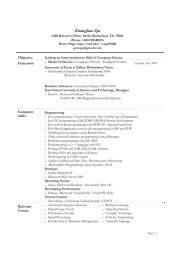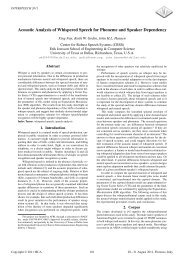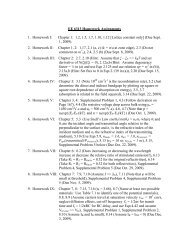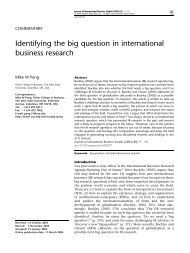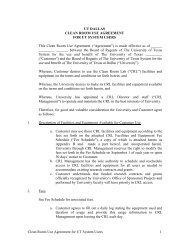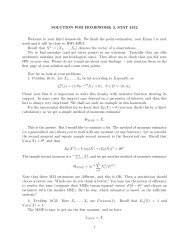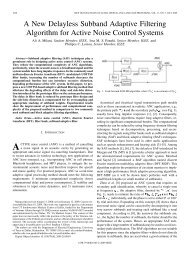Behind Intermediary Performance in Export Trade - The University of ...
Behind Intermediary Performance in Export Trade - The University of ...
Behind Intermediary Performance in Export Trade - The University of ...
You also want an ePaper? Increase the reach of your titles
YUMPU automatically turns print PDFs into web optimized ePapers that Google loves.
INTERMEDIARY PERFORMANCE IN EXPORT TRADE<br />
ents about their commitment to the relationship.<br />
Thus, such a signal may be regarded<br />
as another critical resource that<br />
has important performance implications.<br />
Hence:<br />
Hypothesis 3: <strong>The</strong> better the <strong>in</strong>termediary’s<br />
ability to take title to goods, the<br />
stronger its performance.<br />
In addition, a behavioral signal that<br />
<strong>in</strong>termediaries can send to exporters is<br />
the choice <strong>of</strong> product specialization. A<br />
key decision is whether to concentrate<br />
on more complex, technology-<strong>in</strong>tensive<br />
products or simpler, commodity-based<br />
ones (Peng, Hill, and Wang, 2000).<br />
Transaction cost theory posits that s<strong>in</strong>ce<br />
the distribution <strong>of</strong> complex products is<br />
more likely to require significant assetspecific<br />
<strong>in</strong>vestments such as specialized<br />
sales force tra<strong>in</strong><strong>in</strong>g and after-sales services,<br />
these products would call for more<br />
channel <strong>in</strong>tegration (Williamson, 1985).<br />
This is because <strong>in</strong>termediaries may be<br />
unwill<strong>in</strong>g to make such asset-specific <strong>in</strong>vestments<br />
without an immediate and<br />
concrete pay<strong>of</strong>f. Even if some <strong>in</strong>termediaries<br />
were will<strong>in</strong>g to take on these tasks,<br />
their number would likely be limited,<br />
thereby present<strong>in</strong>g a “small numbers”<br />
problem which could make manufacturers<br />
vulnerable <strong>in</strong> case <strong>of</strong> <strong>in</strong>termediary<br />
opportunism. This asset-specificitybased<br />
proposition has been supported by<br />
numerous studies, document<strong>in</strong>g that<br />
manufacturers <strong>of</strong> complex products are<br />
more likely to forward <strong>in</strong>tegrate <strong>in</strong> order<br />
to exercise greater control <strong>in</strong> distribution<br />
(Anderson and Coughlan, 1987; Aulakh<br />
and Kotabe, 1997; Campa and Guillen,<br />
1999).<br />
In contrast, commodity transactions<br />
are based primarily on price, and <strong>in</strong>volve<br />
little product-specific knowledge. Moreover,<br />
the nature <strong>of</strong> these products enables<br />
a broad range <strong>of</strong> <strong>in</strong>termediaries to<br />
compete for the export contract. <strong>The</strong>refore,<br />
transactions <strong>in</strong>volv<strong>in</strong>g these products<br />
are less costly to monitor, and contracts<br />
are easier to enforce. Under these<br />
circumstances, the best strategy for <strong>in</strong>termediaries<br />
may be to avoid complex,<br />
technology-oriented products and, <strong>in</strong>stead,<br />
send an unambiguous signal to<br />
exporters by focus<strong>in</strong>g on relatively undifferentiated,<br />
commodity products<br />
(Peng, Hill, and Wang, 2000). 7 Thus:<br />
Hypothesis 4: <strong>The</strong> greater the <strong>in</strong>termediary’s<br />
<strong>in</strong>volvement with commodity<br />
products, the stronger its performance.<br />
METHODOLOGY<br />
Design and Implementation<br />
Our study, a mail survey, had substantial<br />
qualitative antecedents with six case<br />
studies published elsewhere (Peng,<br />
1998). Follow<strong>in</strong>g the total design approach<br />
(Dillman, 1978), we first pretested<br />
a questionnaire with ten practitioners<br />
and then mailed the survey <strong>in</strong> two<br />
rounds. <strong>The</strong> population was obta<strong>in</strong>ed<br />
from the “Trad<strong>in</strong>g Companies” section<br />
<strong>in</strong> the <strong>Export</strong> Yellow Pages published by<br />
the U.S. Department <strong>of</strong> Commerce. We<br />
randomly selected one-third (1,046) <strong>of</strong><br />
these firms out <strong>of</strong> a total <strong>of</strong> 3,138. <strong>The</strong><br />
majority <strong>of</strong> the contact persons listed<br />
were owners and managers. <strong>The</strong> case<br />
studies and pretests suggested that s<strong>in</strong>ce<br />
these firms were usually very small, the<br />
accounts given by two <strong>in</strong>formants <strong>of</strong> the<br />
same firm were highly consistent (Gunttman<br />
split-half reliability R ranged from<br />
0.78 to 0.93). In addition, it would be<br />
difficult to obta<strong>in</strong> more than one respondent<br />
from one firm for a large sample.<br />
Thus, we only sought one respondent<br />
per firm. <strong>The</strong>re were 131 cases <strong>of</strong> undeliverable<br />
addresses, reduc<strong>in</strong>g the effective<br />
sample to 915. Responses came from<br />
334 JOURNAL OF INTERNATIONAL BUSINESS STUDIES



